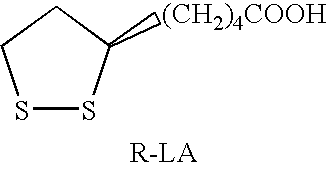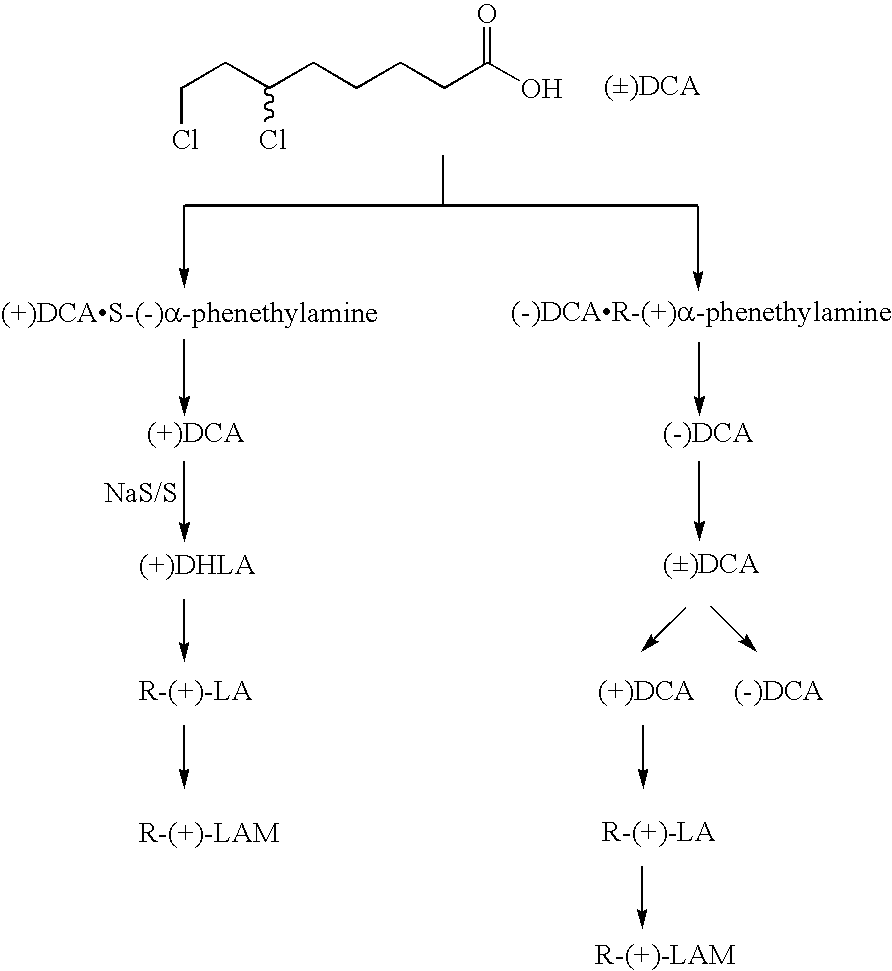Method of preparing R-(+)-alpha-lipoic acid and its salt
a technology of r-(+)-al applied in the field of preparing ralpha-lipoic acid and its salt, can solve the problems of soaring costs, 45% yield rate, waste of half the raw materials,
- Summary
- Abstract
- Description
- Claims
- Application Information
AI Technical Summary
Benefits of technology
Problems solved by technology
Method used
Image
Examples
second embodiment
[0012] According to the present invention, the (−)DCA is converted into (±)DCA by treating the (−)DCA with of lower concentration NaOH, and afterwards, (±)DCA is followed with a resolution process to obtain (+)DCA, to be sulfurized and cyclized into R-(+)-α-LA as well as its salts. The chemical reaction formula is showing below: (M=K—Na—Ca—Mg—Zn—Cu—Fe—Li-Organic alkali)
[0013] It is noted that Ethyl 6, 8-Dichloroocanoic acid (industrial grade), S-(−)-α-phenethylamine and R-(+)α-phenethylamine(industrial grade) are available in the market.
[0014] According to the present invention, the intermediate (±)DCA is through a resolution process first, and then for a synthesizing process to obtain desirable products. Undoubtedly, such procedure would save enormous raw materials and make a solid cost saving. Meanwhile, the final product R-(+)-lipoic acid prepared by the present invention is convenient to transport, storage and application. What is more, the useless (−)DCA could be effectively...
embodiment 1
[0015] Embodiment 1
[0016] 1, 100 g (0.4mol) racemic Ethyl 6, 8-Dichlorooctanoic acid (95% industrial grade) is prepared first, and then treated with an alkali hydrolysis process so as to obtain (±)-DCA 80 g, to be dissolved into 300 ml ethyl acetate, followed by 24 g (0.2 mol) S-(−)-α-phenethylamine, afterwards, gradually cooled down to a temperature range between 0-10° C., overnight, filtered, and ultimately obtain 30 g wet (+)DCA S-(−)-α-phenethylamine salt.
[0017] Afterwards, a recrystallization process is followed, wherein the (+)DCA-S-(−)-α-phenethylamine salt is dissolved in the ethyl acetate, and acidified with diluted hydrochloric acid, and extracted by methylbenzene, and distilled at low temperature to remove solvent, finally obtain 18.8 g (+)-DCA, [α]D25+48-49.6° with a yield rate from 42% to 46%.
[0018] 2, 18.8 g (+)-DCA is converted into 13.1 g R-(+)-lipoic acid according to a method introduced by U.S. Pat. No. 3,223,712 (1965), with a yield rate of 72%, wherein the melt...
embodiment 2
[0020] Embodiment 2
[0021] 10.3 g (0.05 mol) R-(+)-LA prepared by the above embodiment 1 is promptly dissolved into 100 ml anhydrous ethanol, and added with same volume of potassium ethanol / ethanol solution, disposed at a temperature range from 0-10° C., to gradually separate out crystal, filtered at a nitrogen-filled condition, vacuumed and dried, and ultimately obtain ultra-fine R-(+)-LA potassium 9.9 g with a yield rate 81%.
PUM
| Property | Measurement | Unit |
|---|---|---|
| yield rate | aaaaa | aaaaa |
| temperature | aaaaa | aaaaa |
| yield rate | aaaaa | aaaaa |
Abstract
Description
Claims
Application Information
 Login to View More
Login to View More - R&D
- Intellectual Property
- Life Sciences
- Materials
- Tech Scout
- Unparalleled Data Quality
- Higher Quality Content
- 60% Fewer Hallucinations
Browse by: Latest US Patents, China's latest patents, Technical Efficacy Thesaurus, Application Domain, Technology Topic, Popular Technical Reports.
© 2025 PatSnap. All rights reserved.Legal|Privacy policy|Modern Slavery Act Transparency Statement|Sitemap|About US| Contact US: help@patsnap.com


